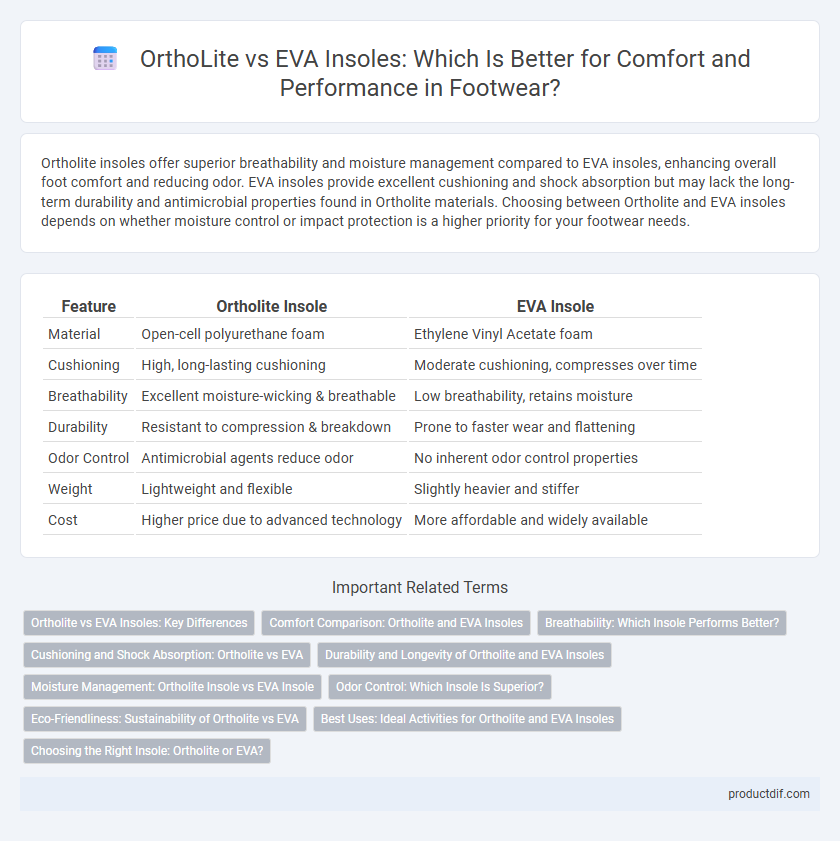Ortholite insoles offer superior breathability and moisture management compared to EVA insoles, enhancing overall foot comfort and reducing odor. EVA insoles provide excellent cushioning and shock absorption but may lack the long-term durability and antimicrobial properties found in Ortholite materials. Choosing between Ortholite and EVA insoles depends on whether moisture control or impact protection is a higher priority for your footwear needs.
Table of Comparison
| Feature | Ortholite Insole | EVA Insole |
|---|---|---|
| Material | Open-cell polyurethane foam | Ethylene Vinyl Acetate foam |
| Cushioning | High, long-lasting cushioning | Moderate cushioning, compresses over time |
| Breathability | Excellent moisture-wicking & breathable | Low breathability, retains moisture |
| Durability | Resistant to compression & breakdown | Prone to faster wear and flattening |
| Odor Control | Antimicrobial agents reduce odor | No inherent odor control properties |
| Weight | Lightweight and flexible | Slightly heavier and stiffer |
| Cost | Higher price due to advanced technology | More affordable and widely available |
Ortholite vs EVA Insoles: Key Differences
Ortholite insoles feature open-cell polyurethane foam that provides superior breathability and moisture management compared to EVA insoles, which are made of ethylene-vinyl acetate known for lightweight cushioning and flexibility. Ortholite foam maintains long-term cushioning and resists compression over time, whereas EVA insoles tend to compress and lose support with extended use. Ortholite's antimicrobial properties reduce odor buildup, offering enhanced comfort and hygiene relative to standard EVA foam insoles.
Comfort Comparison: Ortholite and EVA Insoles
Ortholite insoles offer superior breathability and long-lasting cushioning due to their open-cell foam structure, enhancing overall foot comfort during extended wear. EVA insoles provide excellent shock absorption and lightweight support, making them ideal for high-impact activities. Ortholite's moisture-wicking properties prevent odor buildup, while EVA focuses more on responsiveness and durability in diverse footwear applications.
Breathability: Which Insole Performs Better?
Ortholite insoles outperform EVA insoles in breathability due to their open-cell polyurethane foam structure, which promotes superior air circulation and moisture wicking. This enhanced ventilation reduces foot odor and keeps feet drier during extended wear. EVA insoles, while lightweight and cushioning, lack the same porous design, resulting in less effective breathability compared to Ortholite.
Cushioning and Shock Absorption: Ortholite vs EVA
Ortholite insoles are crafted with open-cell polyurethane foam, providing superior long-term cushioning and enhanced breathability, which helps maintain comfort and moisture control. EVA (ethylene vinyl acetate) insoles offer excellent initial shock absorption due to their lightweight and flexible properties but may compress faster over time, reducing cushioning effectiveness. For sustained impact protection and cushioning in footwear, Ortholite insoles typically outperform EVA by retaining their structure and resilience longer under repeated use.
Durability and Longevity of Ortholite and EVA Insoles
Ortholite insoles provide superior durability due to their open-cell polyurethane foam structure, which resists compression and maintains cushioning over time. EVA insoles, made from ethylene-vinyl acetate, offer good initial comfort but tend to break down and lose their shape faster under repeated stress. The longevity of Ortholite insoles typically surpasses EVA, making them a preferred choice for long-lasting footwear comfort.
Moisture Management: Ortholite Insole vs EVA Insole
Ortholite insoles excel in moisture management due to their open-cell polyurethane foam, which promotes breathability and quick drying, reducing odor and sweat buildup. EVA insoles, made from ethylene-vinyl acetate foam, offer moderate moisture resistance but lack the advanced breathability and antimicrobial properties found in Ortholite. Choosing Ortholite insoles significantly enhances foot comfort by maintaining a drier environment during prolonged wear.
Odor Control: Which Insole Is Superior?
Ortholite insoles are superior in odor control due to their open-cell polyurethane foam infused with antimicrobial agents that inhibit bacterial growth, effectively reducing foot odor over time. EVA insoles lack inherent antimicrobial properties, making them less effective at odor prevention despite offering good cushioning. For long-lasting freshness and odor control, Ortholite insoles provide a more hygienic and breathable solution compared to EVA.
Eco-Friendliness: Sustainability of Ortholite vs EVA
Ortholite insoles are made from recycled rubber and eco-friendly open-cell polyurethane, offering superior breathability and durability while supporting sustainable practices. EVA insoles, typically crafted from ethylene vinyl acetate foam, often involve non-biodegradable petrochemical components with limited recycling options. Ortholite's commitment to using renewable materials and reducing carbon footprint establishes it as a more eco-friendly choice compared to conventional EVA insoles.
Best Uses: Ideal Activities for Ortholite and EVA Insoles
Ortholite insoles excel in providing long-lasting cushioning and breathability, making them ideal for running, hiking, and high-impact sports where moisture management and comfort are crucial. EVA insoles offer lightweight support and shock absorption, best suited for casual wear, walking, and low to moderate-intensity activities requiring durable yet flexible comfort. Choosing between Ortholite and EVA depends on the activity's intensity level and the need for breathability versus lightweight resilience.
Choosing the Right Insole: Ortholite or EVA?
Ortholite insoles offer superior breathability and moisture-wicking properties, enhancing comfort and odor control for long-lasting wear. EVA insoles provide excellent cushioning and shock absorption with lightweight durability, making them ideal for high-impact activities. Selecting the right insole depends on prioritizing breathability and antimicrobial benefits with Ortholite or opting for EVA's responsive support and lightweight design.
Ortholite insole vs EVA insole Infographic

 productdif.com
productdif.com